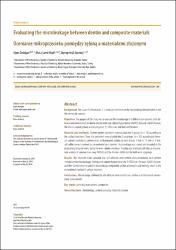Evaluating the microleakage between dentin and composite materials
Künye
Özdoğan, A., Akyıl, M. Ş., & Duymuş, Z. Y. (2018). Evaluating the microleakage between dentin and composite materials. Dental and medical problems, 55(3), 261–265. https://doi.org/10.17219/dmp/91780Özet
Background. For successful restoration, it is necessary to minimize the microleakage between dentin and the composite material. Objectives. the purpose of this study was to evaluate the microleakage of 2 different resin cements (self-adhesive and conventional) on dentin treated with acid, sodium hypochlorite (NaOCl), the acid-NaOCl mixture, the erbium-doped yttrium aluminum garnet (Er:YAG) laser, and their combination. Material and methods. Seventy dentin specimens were divided into 7 groups (n = 10) according to the surface treatment. Then, the specimens were divided into 2 subgroups (n = 35) according to the resin cement used during cementation with prepared composite resin blocks 5 mm x 11 mm x 3 mm: self-adhesive resin cement or conventional resin cement. Microleakage was scored and recorded at the occlusal and gingival levels, along the resin-dentin interfaces. the data was analyzed with the use of univariate analysis of variance (two-way ANOVA) and the Kruskal-Wallis test for both resin subgroups. Results. the obtained results revealed that self-adhesive resin cement and conventional resin cement showed similar microleakage. Etching with sodium hypochlorite, the Er:YAG laser, the acid-NaOCl mixture, and their combination resulted in microleakage comparable to that achieved in acid etching, which is the conventional method of surface treatment. Conclusions. Microleakage exhibited by self-adhesive resin cement was similar as in the case of conventional resin cement.


















